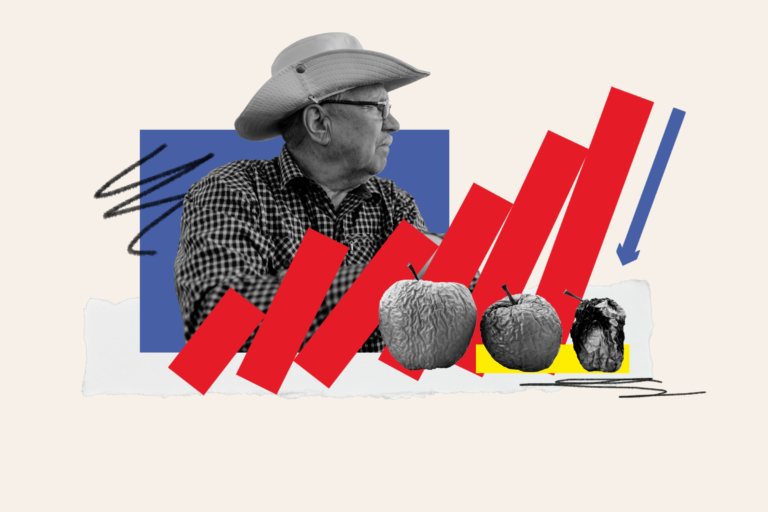America’s farmers are locked in a generational crisis, fending off an array of threats that could jeopardize food supplies and spell financial disaster for those often hailed as the “backbone of the nation.”
“They love their way of life, and they love that dirt,” President Donald Trump said this week, in a somewhat off-piste response to a question on the importance of farmers. “They don’t know how to do anything else, but they don’t want to do anything else.”
But the current storm of rising debt, declining commodity prices and labor shortfalls has begun to echo the great Farm Crisis of the 1980s and may be testing the love farmers hold for their profession.
Farm sector debt is expected to reach a record $561.8 billion in 2025, according to data from the U.S. Department of Agriculture, up 3.7 percent from 2024. The Kansas City Federal Reserve has attributed this primarily to increased lending for small- and mid-sized farms.
This growing financial pressure has also pushed up bankruptcies. Researchers at the University of Arkansas recently found that Chapter 12 filings—specifically for farmers and family fishermen—reached 88 in the first quarter of the year, nearly doubling the previous year’s figure.
“Bankruptcies are on the rise and you will see many more on the auction block in the coming months especially this fall,” said John Boyd, a crop and livestock farmer and founder of the National Black Farmers Association.

Tariffs Putting Pressure on Crop Prices
Boyd has been farming since the early 1980s, currently growing soybeans, corn and wheat across 1,500 acres in Virginia while raising 150 head of beef cattle. He told Newsweek that 2025 marked the first time in his career that he was unable to receive an operating loan, which provides farmers working capital needed to cover daily expenses, and blamed this on the trade policies of the current administration.
“I was turned down by banks for the simple fact of low commodity prices due to the president’s tariffs,” he said.
The higher costs for foreign importers have dampened foreign demand, leading to further reductions in the price of America’s agricultural exports. Corn futures, as an example, have fallen about 15 percent since the start of the year, according to TradingEconomics.
“Mexico buys U.S. corn, China buys soybeans,” Boyd said. “We cannot survive on low crop prices with input costs at an all-time high.I have not seen such political chaos like this, and I have been farming since 1983.”
A May survey by Purdue University found that a strong majority (70 percent) of U.S. farmers believe Trump’s tariffs will strengthen U.S. agriculture—some telling Investigate Midwest that they will help the U.S. pressure China to boost its imports.
But according to Caleb Ragland, president of American Soybean Association, the “tit-for-tat trade war”—which has still not given way to a full-fledged deal despite several weeks of negotiations—could see American soybean farmers lose out on this critical market.
“Make no mistake, American soybean farmers do stand at the edge of a cliff and will suffer if tariffs are not replaced with trade agreements that reduce tariffs before our harvest this fall,” Ragland said in his May testimony before the U.S. Senate Finance Committee.
Vanishing Farm Workforce
“American farm and ranch families need a workforce that is ready, willing and available,” said Michael Marsh, president and CEO of the National Council of Agricultural Employers (NCAE). “The shortage of these workers is perhaps the most significant challenge facing U.S. agriculture.”
“This year, the labor shortfall in U.S. agriculture will exceed 400,000 jobs,” he added. “Technology will not fill that need.”
The California Farm Bureau listed “access to a stable workforce” among the key challenges facing America’s farmers, and pointed Newsweek to its recent statement warning that “current immigration enforcement activity has caused disruptions to farming operations.”
Farms have been one the key targets of the administration’s crackdown on illegal immigration, raids by Immigration and Customs Enforcement (ICE) resulting in worker shortages and even rotting crops as the country heads into harvest season.

Mario Tama/Getty Images
“The president’s immigration policies have hurt America’s farmers,” Boyd said. “Who’s going to do the hard work that is required in 100-degree heat and enduring work conditions?”
“A significant portion of our domestic workforce is here in unauthorized status,” Marsh said. “Congress has failed since 1986 to pass meaningful agricultural labor reform. As a result of that and stepped-up efforts to remove unauthorized persons from the U.S., people on our farms and ranches are frightened.”
However, beyond the current enforcement actions, Marsh said the issue has been exacerbated by labor regulations, which “expanded significantly during the last administration.”
“For instance, in just 18 months the Biden administration issued 3,000 new pages of regulations for users of the temporary H-2A visa program,” he said, referencing changes made by the Department of Labor in 2024.
That, he said, has been “jeopardizing the ability of farm and ranch families to sustain the enterprise but also jeopardizing the safety and security of our people.”
Consequences of America’s Latest Farm Crisis
For the consumer, the struggles of American farmers in 2025 are beyond simply a rural community crisis and carry direct repercussions at the checkout line and dinner table.
“When our farmers face persistent challenges, the broader consequences can include higher food prices, fewer choices at the grocery store and reduced access to the variety and quality of food Americans have come to expect,” California Farm Bureau President Shannon Douglass told Newsweek. “In the long run, it could also weaken our domestic food supply and make the U.S. more reliant on imports.”
For farmers, the impacts could be even more dire.
“We as Black farmers are facing extinction!” said Boyd, adding that this group has “never really benefited” from the billions in subsidies paid annually by the government.
The sweeping tax and spending package signed into law by Trump on July 4 frees up significant funds to support America’s farmers. The “One Big Beautiful Bill Act” will continue commodities programs and boosts subsidies for farmers by an estimated $66.4 billion over 10 years.
While a lifeline for many, analysis has shown that these benefits will be unevenly distributed, depending on the type of crops are grown, with larger farms and those in the South expected to reap the greatest benefits.
“It fails to offer any meaningful support for independent farmers—who face increasing challenges from low prices, trade wars and the climate crisis—and the communities they feed,” was the response of the National Family Farm Coalition, a nonprofit that advocates for small- and medium-scale family farmers and fishing communities.
And to others, while subsidy programs are a step in the right direction, they fall short of addressing the structural issues plaguing U.S. agriculture.
“There are provisions included in the Big Beautiful Bill that benefit farmers and ranchers,” the California Farm Bureau said. “However, a comprehensive farm bill is still needed.”
Newsweek has reached out to the Department of Agriculture via email for comment.


